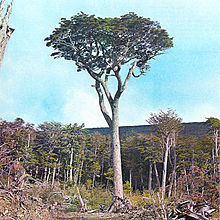Nothofagus betuloides
| Magellan's beech | |
|---|---|

| |
| Scientific classification | |
| Kingdom: | Plantae |
| Clade: | Tracheophytes |
| Clade: | Angiosperms |
| Clade: | Eudicots |
| Clade: | Rosids |
| Order: | Fagales |
| Family: | Nothofagaceae |
| Genus: | Nothofagus |
| Subgenus: | Nothofagus subg. Nothofagus |
| Species: | N. betuloides
|
| Binomial name | |
| Nothofagus betuloides | |
| Synonyms[2] | |
| |
Nothofagus betuloides, Magellan's beech[1] or guindo, is a tree native to southern Patagonia.
In 1769, Sir Joseph Banks collected a specimen of the tree in Tierra del Fuego during Captain Cook's first voyage.[3]
Its occurrence on Hornos Island earns it the distinction of being the southernmost tree on Earth.[4]
Distribution[edit]
Nothofagus betuloides grows from southern Chile and southern Argentina (40°S) to Tierra del Fuego (56°S). It is found from sea level to 500 m (1,600 ft) above mean sea level. One specimen growing near the southeastern corner of Hornos Island (Cape Horn) was identified in 2019 as the southernmost tree in the world.[4]
Description[edit]
It is an evergreen tree up to 25 m (82 ft) tall, with a columnar appearance. In its natural environment, it tolerates cold winters and absence of heat in summer. Specimens from the southern forests resist temperatures down to −20 °C (−4 °F).
Cultivation[edit]
It succeeds in Scotland. Trees planted in the Faroe Islands, which were imported directly from its southernmost distribution in Tierra del Fuego, have turned out to be very hardy.[5]
The wood has beautiful marks, and is pinkish, hard, and semiheavy; it is used in furniture and construction.
-
Illustration from specimens collected by the Endeavour, Tierra del Fuego, 1769
-
Fagus betuloides in Joseph Dalton Hooker's Flora Antarctica 1844–1846, from the Ross expedition of 1839–1843
References[edit]
- ^ a b Baldwin, H. (2018). "Nothofagus betuloides". IUCN Red List of Threatened Species. 2018: e.T96477315A96479945. doi:10.2305/IUCN.UK.2018-2.RLTS.T96477315A96479945.en. Retrieved 19 November 2021.
- ^ "The Plant List: A Working List of All Plant Species".
- ^ Kew gardens, or A popular guide to the Royal Botanic Gardens of Kew by Sir W.J. Hooker
- ^ a b Welch, Craig (July 2020). "The tree at the bottom of the world—and the wind-blasted trek to find it". National Geographic. Archived from the original on July 7, 2020. Retrieved July 13, 2020.
- ^ Højgaard, A., J. Jóhansen, and S. Ødum (eds) 1989. A century of tree planting in the Faroe Islands. Føroya Frodskaparfelag, Torshavn.
- Donoso, C. 2005. Árboles nativos de Chile. Guía de reconocimiento. Edición 4. Marisa Cuneo Ediciones, Valdivia, Chile. 136p.
- Hoffmann, Adriana. 1998. Flora Silvestre de Chile, Zona Central. Edición 4. Fundación Claudio Gay, Santiago. 254p.
- Rodríguez, R. & Quezada, M. 2003. Fagaceae. En C. Marticorena y R. Rodríguez [eds.], Flora de Chile Vol. 2(2), pp 64–76. Universidad de Concepción, Concepción.
- "Nothofagus betuloides". Encyclopedia of Chilean Flora. Retrieved 2009-06-27.
- "Magellan's beech". Chilebosque. Retrieved 2009-06-27.
- "Nothofagus betuloides in the Netherlands". PlantenTuin Esveld. Retrieved 2009-06-27.



